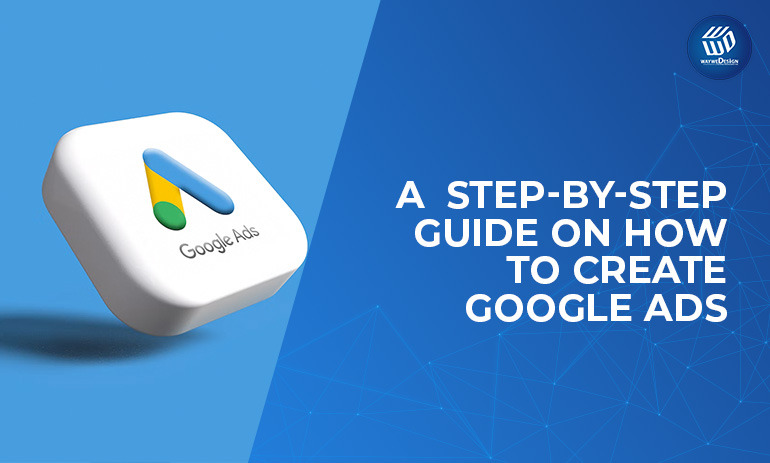Way WeDesign, India

A Step-by-Step Guide on How to Create Google Ads
Google Ads, also known as Google AdWords, is a powerful online advertising platform provided by Google. Itenables companies to connect with their target market and increase website traffic. With its extensive reach and targeting options, Google Ads has become an essential tool for businesses of all sizes. In this blog post, we will provide a comprehensive step-by-step guide on how to create Google Ads and leverage this service to promote your business effectively.
Step 1: Set Up a Google Ads Account :
To start creating Google Ads, you need to set up an account. Visit the Google Ads website and click on the "Start Now" button. Enter your login information to access your Google account if you already have one. If not, register for a new Google account. To finish the account setup procedure, adhere to the instructions. Make sure to provide accurate information about your business, including your website URL and billing details. Once your account is set up, you can access the Google Ads dashboard.
Step 2: Define Your Advertising Goals :
Before diving into creating your Google Ads, it's crucial to define your advertising goals. Analyse a little bit and understand, What are the objectives of your advertisements, Are you trying to improve sales, lead generation, or website traffic? Clearly defining your goals will help you create effective ad campaigns and measure their success. Take the time to analyze your business objectives and align them with your advertising goals. This will ensure that your Google Ads campaigns are tailored to meet your specific needs.
Step 3: Choose Your Campaign Type :
Google AdWords offers a diverse array of campaign types to suit a wide range of advertising objectives. The most sought-after forms of advertising include Search Network, Display Network, Video, Shopping, and App campaigns. Each campaign type possesses unique characteristics and targeting opportunities. It is crucial to select the campaign type that harmonizes with your advertising goals and the essence of your business. Factors such as your target audience, financial resources, and the kind of content you wish to promote should be carefully considered. By making a prudent choice regarding the campaign type, you can optimize the efficacy of your Google Ads campaigns to their fullest potential.
Step 4: Set Up Your Campaign :
Once you've chosen your campaign type, it's time to set up your campaign. Give your campaign a name that accurately conveys its objective. Choose the region in which you would want your advertisements to appear next. By doing this, you can be sure that the appropriate people see your adverts. By setting a daily budget, outline the maximum amount you are willing to allocate for your campaign on a daily basis, ensuring prudent financial management. Furthermore, deliberate upon your preferred bidding strategy, as it serves as a determiner of the payment methodology for your ads. Google Ads offers a plethora of bidding options, catering to individual preferences, whether it be manual bidding or automated bidding.
Step 5: Create Ad Groups :
Ad groupings are something you must build within your campaign. You can arrange your adverts according to particular topics or keywords by using ad groups. This helps you target your ads to the right audience and improve their relevance. For example, if you're running a campaign for a clothing store, you might have ad groups for men's clothing, women's clothing, and accessories. Create relevant ad groups and assign keywords to each group. This helps Google determine where to display your ads based on the search queries entered by users.
Step 6: Write Compelling Ads :
The success of your Google Ads campaign depends on the quality of your ads. Write compelling ad copy that grabs the attention of your target audience and entices them to click. Include relevant keywords in your ad copy to improve its visibility. Highlight the unique selling points of your products or services and provide a clear call-to-action. Experiment with different ad formats, such as text ads, image ads, or responsive ads, to see what works best for your campaign. Remember to keep your ads concise, engaging, and relevant to your target audience.
Step 7: Set Up Ad Extensions:
Your ads become more interesting and educational by including links and other information with ad extensions. Ad extensions from Google AdWords include phone, location, and sitelink extensions, among others. Set up relevant ad extensions to enhance the visibility and effectiveness of your ads. For example, if you have a physical store, adding a location extension will display your address and a map to help potential customers find you easily. Experiment with different ad extensions to see which ones resonate with your audience and improve the performance of your ads.
Step 8: Monitor and Optimize Your Campaign :
Once your Google Ads campaign is live, it's crucial to monitor its performance and make necessary optimizations. Regularly review your campaign's metrics, such as click-through rate (CTR), conversion rate, and cost per conversion. Use the data to identify areas for improvement and make adjustments to your campaign. Consider tweaking your ad copy, adjusting your bidding strategy, or refining your targeting settings. Continuously monitor and optimize your campaigns to maximize their performance and achieve your advertising goals. Google Ads provides various tools and reports to help you track and analyze the performance of your campaigns.
Creating Google Ads is a strategic process that requires careful planning and execution. By following the comprehensive step-by-step guide outlined in this blog post, you can create effective Google Ads campaigns that drive traffic, generate leads, and boost sales for your business. Remember to define your advertising goals, choose the right campaign type, create compelling ads, and continuously monitor and optimize your campaigns for maximum results. With Google Ads, you have the power to reach your target audience and achieve your business objectives effectively.
